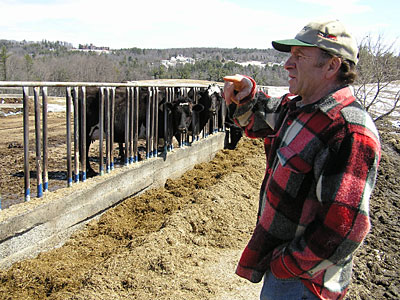 |
| Switching from conventional to organic dairying, partly by reducing herd size, helped save the Bragg Homestead farm in Sidney. Wayne Bragg talks about the transition to organic as his cows eat silage in this outdoor lot. English photo. |
By Jean English
“Organic is not business as usual,” says Wayne Bragg, an organic dairy farmer in Sidney, Maine. The bicentennial farm where he and his wife, Peggy, live was established in 1772 by John Bragg II, who took up a claim and built a little log cabin by the Kennebec River. The farmhouse was built in the 1880s by Caleb Bragg, who made his money in the bookbinding business. Now the farm continues, thanks to the organic market. “You’ve got a guaranteed price and a quality incentive,” Bragg notes. “You’ve got the ability to cut back on your herd and do a better job and make as much or more money than before. That’s what I’ve been able to do: cut back my numbers and make a living.”
Cutting his herd to the point where he could raise most of its feed and tend each cow carefully were keys to Bragg’s transition to organic dairying. From 1975 to the mid-’80s, Bragg had “10 good years … Then things got bad.” He blames Carter- and Reagan-era policies for problems in the dairy industry. During the Carter years, the government had a policy of taking all the milk farmers could produce, with yearly raises. This led to surpluses. Then Reagan’s administration eliminated price guarantees: “It would go up to $17, down to $12. They were starving us right to death.” With the elimination of the 10% investment tax credit on new machinery and with taxing cattle at 100%, “right off my taxes doubled and my income dropped. I had to learn how to borrow money, how to make payments.” His parents lent him money at one point, and he had to borrow another $13,000 in 1991. “I was going in the hole quick. I told my wife, if this happens a third time, I’m done.”
A couple of years ago, the price of milk was going down, Bragg was driving a school bus in addition to farming, and his wife was working outside of the home. “We were running pretty ragged. Then I found out about this organic fad. Milk’s milk, I thought. But I found out! It’s a better way to farm.”
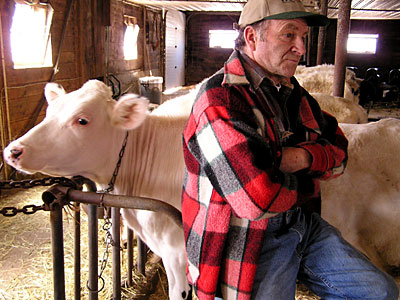 |
| Wayne Bragg with his heifers. “The small farmer may come back, thanks to organic. It’s given people a choice,” he says. English photo. |
Transitioning was not difficult because he hadn’t used synthetic or prohibited chemicals on his fields, and he had an abundance of land. He had 63 cows then, and he thought that cutting back to about 20 might be manageable. “I sold cows all through the summer when the price of milk was low. By fall I was down to 38 or 40 cows. By the following fall I was down to 31. Then I had 14 heifers calve; that brought me up to 44.” He has 41 milking cows now, “basically a Holstein herd,” and several Holstein-Jersey cross calves, as well as one Shorthorn, and this number is working well for him. He’s been selling organic milk to Horizon Organic Dairy, based in Colorado, for almost two years.
Being able to get rid of problem cows eased his transition to organic, too. Instead of the expense of treating them and having the vet visit the farm, he was able to sell them and reap some income.
Pasture Management
Bragg has 37 acres of “excellent” pasture on clay-loam soil. His paddocks vary from about 2 to 7 acres, and his cows graze them from a few to 10 days each. “If I was really ambitious, I’d have two days here, two days there, but that’s more labor intensive. But if you want to make some money with milk, the more paddocks, the better.” He keeps his cows on a pasture until it’s chewed down, then moves them. Last year he had a 40-day rotation (i.e., the first pasture wasn’t used again for 40 days). He clips each pasture after the cows move to the next so that the feed doesn’t get coarse – except during droughts, when he leaves the pasture alone after it’s grazed. He moves the cows when the herd’s milk production drops by 100 pounds.
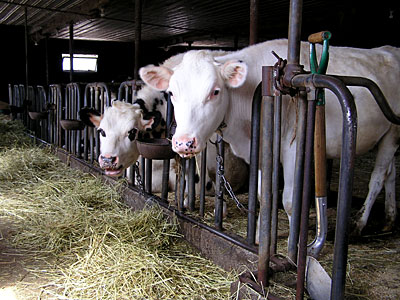 |
| Heifers enjoy their hay. English photo. |
Bragg spreads high magnesium lime in the stalls and barnyard to help prevent foot rot and to make the areas less slippery. This lime ends up in the manure and, thus, helps maintain a good pH in the pastures. He spreads manure on pastures where needed, spring or fall, when the weather is appropriate.
Feed
The cows each get 3 to 4 pounds of cornmeal with minerals twice a day and produce an average of 50 to 55 pounds of milk in the summer.
He feeds his cows grain containing 16% protein through the winter, getting by with 6 tons a month. “A few cows look a little thin, but that’s ok,” he says. “A little thin is much better than too fat,” notes MOFGA’s assistant director of technical services, Diane Schivera. “Excess fat leads to even more serious metabolic problems.”
“They’re milking well,” Bragg continues. “Last year I made more than $116,000 in milk and paid $16,000 in grain.” He buys his feed from P.A. Lessard in Quebec. Growing his own grain isn’t an option, because he’s busy repairing and building fences and maintaining equipment in the spring.
In the first 60 days, his calves get a half milk:half water mix. His calves hadn’t had any grain as of April, but were getting a mix of one-third milk and two-thirds water by then. Each calf got about 6 quarts of this fermented, milky water twice a day. “Having that soured milk, they eat more hay. That makes them wicked hardy. It gets their rumen going. It’s a cheap way to raise animals. If the price of grain is high, I have an alternative.”
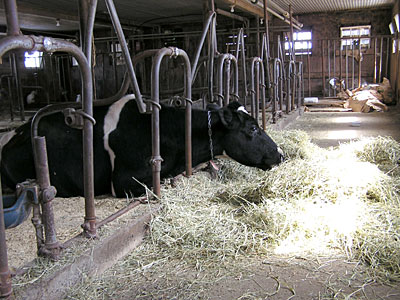 |
| A cow rests in the barn while feeding on organic hay. English photo. |
Bragg cuts his hay fields only once. “Most of the second crop hay stays in the field. It’s growing to feed my soil.” The only time he does a second cutting is when he has put manure down the previous fall or will apply it the following fall. Otherwise, “what’s left in the plant feeds back into the soil. It holds moisture, makes the worms work better, makes the land healthier. Unless you have a lot of hen or cow manure, you won’t keep the land up if you have a second cutting. You’ll end up buying feed.” Not having to do a second cutting gives Bragg time for other chores, too, such as building maintenance.
The hay that is cut is baled into round and square bales, and Bragg puts silage in his bunker silo. The square bales are more convenient in his barn; the round ones provide feed outdoors for dry cows and bred heifers. Digestive problems are minimal.
Herd Health – Have Your Best Man Milking
Bragg gives his cows aspirin for some problems. It works well for injured, swollen feet, and he’ll give cows about 6 tablets of aspirin twice a day for a week to cure hoof rot, supplementing with a rumelax bolus so that the aspirin doesn’t make their stomachs too acidic. Injured teats are simply treated with an iodine dip and dried off.
Hoof rot is controlled by spreading lime in the stalls and barnyard. Hooves are trimmed annually, as well.
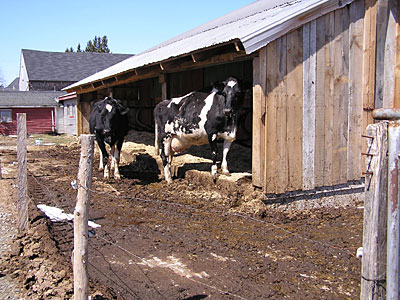 |
| Bragg’s herd consists primarily of Holsteins and Holstein-Jersey cross calves. He also has one Shorthorn. A shed gives cows free access to shelter. English photo. |
Mastitis is controlled primarily through careful attention to milking and by culling problem cows. “Milking is serious business,” says Bragg. “You want your best man milking. I’m wicked fussy.” When his wife or daughter help milk, they use four milkers; when he’s milking alone, Bragg uses only three milkers so that he’s aware of each cow’s production and potential problems. He makes sure quarters don’t get overmilked. “Having the machine on after the udder is empty causes stress on the udder.”
He bought bigger claws for his milking machines to accommodate fast-milking cows; otherwise, flooding (of smaller claws) contributed to mastitis.
When Bragg knows that a cow had a problem with a particular quarter the previous year, he takes the milking machine off that quarter before it’s empty and strips the quarter out by hand. He hasn’t had any problems with mastitis — or any visits from the vet — this year. A California mastitis tester helps him identify this problem if he does suspect it. He also calls Horizon Organic every week to check the quality of his milk. “So far I’ve been able to make the high quality this year. Last month’s check, I made $1,010 extra just on butterfat and quality product. Organic gives you a great incentive to do a good job.”
If Bragg’s careful attention still doesn’t cure a cow of mastitis and the problem occurs a second or third time, he’ll dry up the cow in that quarter or get rid of the cow.
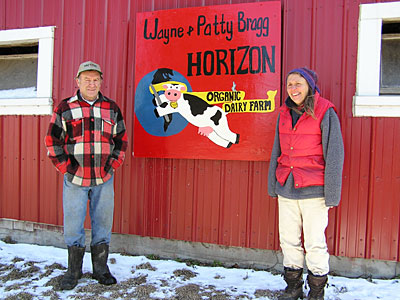 |
| Patty Bragg painted the signs that advertise the farm. Diane Schivera, MOFGA’s assistant technical services director, is shown here with Wayne Bragg. English photo. |
Bragg finds irony in the fact that in the ’60s, when farms got big and invested big money in their operations, farmers would hire someone to do the milking – “the most important job on the farm. The milker can notice a problem early, before it’s serious.”
He also differs with people who want to make as much milk as possible from a cow. “I got to the point last year, I was so tired, I said, ‘All I want is healthy cows. Then we’ll take it from there. I’ll feed them the best feed I can, give them a little grain, and get the most milk out of them from what I’ve raised for them.’ I don’t want more than my pasture can take care of, because that’s where I’m making my money. I can milk 10 more cows, but I bet I wouldn’t make a penny more, because I’d be putting the grain to them – I wouldn’t have the feed for them.” He says that a ratio of one cow per acre works well, depending on soil type and weather.
Breeding
Bragg’s heifers are bred so that they calve out on late fall and winter feed, then they “milk pretty darn good right through the winter” and into spring. In the summer, dry cows get separate pasture, with round baled hay. They seem to calve out better this way.
Daily Routine
Bragg feeds silage to his milkers each morning outside; he scrapes the manure from his barnyard one morning, and feeds dry cows and bred heifers round bales of hay the next morning. “So I get two things done before milking.” He milks at 7 a.m. and 6 p.m. He doesn’t do seasonal milking, because he wants year-round income, but he thinks that a seasonal routine would work “for some of these small guys.” He knows one, for example, who has a dozen cows, drives a school bus during the school year, and makes most of his milk in the summer. “This gives him an income in the summer when he doesn’t have a job.”
Barriers to Organic
Organic dairying won’t solve all of the problems in this industry. “Some people have so much debt, or they haven’t got the land or feed or pasture,” Bragg explains. In such a situation, “I would have quit years ago. I never would have gotten that big. You don’t see any smart businessmen who want to make money milking cows. You’ve got to like the lifestyle and independence.”
Even within the organic industry, he sees problems with large-scale farms in the Midwest or West. “Organic should be the small farmer, [the cows] grazing.”
Those who want to be certified-organic may be put off by the paperwork involved in getting certified. “It’s time consuming,” says Bragg. “They have to change their ways. Grain is going to cost money. If I couldn’t have downsized, I wouldn’t have been so willing to do it. But I knew I could downsize and eliminate my problem cows.” If someone is milking 70 cows, Bragg thinks that farmer can “sell a bunch of cows and pay off his debt,” maintain about 50 milkers, and make more money than when he or she was milking 70 cows.
Advice to New Farmers
People who want to get into dairying should start as small as possible and go organic, says Bragg. He thinks 20 cows may be the minimum to make some money, and the maximum depends on whether the farmer is working off the farm debt or not. If one member of a couple can work off the farm, the couple can pay for the necessary expenses to get started. “The small farmer may come back, thanks to organic. It’s given people a choice.”
One of those young farmers may be Bragg’s daughter Amy. Of his and his wife’s four children, all in their 20s now, two love farming. His daughter already helps with the milking, a job that enables her to stay home with her baby the rest of the day. Bragg foresees a time when he’s 62 years old (five years from now) and his daughter is milking 20 cows and Bragg himself is the helper. His son who enjoys farming works for Magee Construction now but may come back when the time is right. “Time will tell if this happens,” says Bragg. He also has a part-time helper, Eric Lastella, who helps with chores, building maintenance, cutting wood, and so on.
Organic dairy farming “is a great life!” Bragg concludes. “I liked the ’50s. It’s like going back 50 years, organic is.”
Thanks to Diane Schivera for assistance in preparing this article. For information about transitioning to organic dairying, or other questions about raising animals organically, please contact Diane at the MOFGA office (568-4142) or a [email protected].
Saving Farmland Easier with Expanded Web Site
Landowners, agricultural professionals and citizens concerned about the loss of agricultural land now have easier access to assistance, thanks to an expanded Farmland Information Center (FIC) Web site at www.farmland.org. The FIC, a partnership between American Farmland Trust and the USDA’s Natural Resources Conservation Service (NRCS), is available at www.farmlandinfo.org and by calling 800-370-4879.
Launched in 1994, the FIC maintains an growing collection of state laws, reports and other literature relating to farm and ranch land protection. It also offers an “answer service” to provide direct technical assistance via phone, email and fax. In addition, the FIC staff monitor and report on farmland protection activities around the country, and identify, acquire and develop new materials.
According to Jennifer Dempsey, assistant director of AFT’s Technical Assistance Services, the new format simplifies finding materials such as statistics about the loss of farmland and its consequences, sample ordinances and documents from successful initiatives around the country, and fact sheets and articles that convey basic information about farmland protection approaches and the consequences of the loss of farmland.
Jim Johnson, who is responsible for land use and water planning for the Oregon Department of Agriculture, turned to the FIC when he began exploring new administrative rules for the state’s right-to-farm law. “Instead of trying to reinvent the wheel, I wanted to find out what other people have done that’s been successful,” he said.
American Farmland Trust is a national nonprofit organization working with communities and individuals to protect the best land, plan for growth with agriculture in mind and keep the land healthy. AFT provides a variety of services to landowners, land trusts, public officials, planners and agricultural agencies, such as workshops on estate planning and farmland protection, Cost of Community Services studies, farmland protection program development and agricultural economic development. AFT’s Technical Assistance Services division is located in Northampton, Mass. Phone: 413-586-9330. AFT’s national office is located in Washington, D.C. Phone: 202-331-7300. For more information, visit www.farmland.org.
Horizon Organic Salutes Farmers
In February, Horizon Organic Holding Corporation announced the winners of its annual Exceptional Quality Awards. From Maine to California, over 200 organic dairy farms produce milk for Horizon Organic’s certified organic foods. The Exceptional Quality Awards recognize the top 10 percent of Horizon Organic farmer partners in each state whose milk is the highest quality within Horizon Organic’s network. To be considered for the award, producers must ship one full calendar year of organic milk, and the average test results for each shipment of that milk must be among the best in their respective states. In Maine, Henry Perkins of Bull Ridge Farm in Albion and Wayne Bragg of Bragg Homestead in Sidney received awards.
Horizon Organic signed on more than 35 new farmers nationwide in 2003, and an additional 50 new Horizon Organic farmers are in the process of receiving organic certification and will begin contributing to Horizon Organic’s supply early next year.
The organic industry is expected to reach 30 billion dollars in sales by 2007, and dairy accounts for over 26 percent of those sales.
Horizon Organic is soliciting new farmers who may be interested in transitioning to organic farming. For more information, please contact Cindy Masterman in the East at 888-648-8377, or Neal Forsthoefel in the Midwest and West at 800-237-2711, extension 159.

